Slicers are one of my favorite feature in Excel. And here is a quick demo to show why they are my favorite.
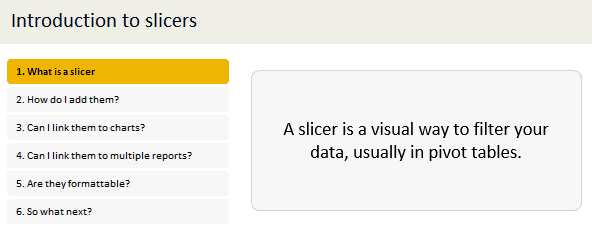
Slicers – what are they?
Slicers are visual filters. Using a slicer, you can filter your data (or pivot table, pivot chart) by clicking on the type of data you want.
For example, let’s say you are looking at sales by customer profession in a pivot report. And you want to see how the sales are for a particular region. There are 2 options for you do drill down to an individual region level.
- Add region as report filter and filter for the region you want.
- Add a slicer on region and click on the region you want.
With a report filter (or any other filter), you will have to click several times to pick one store. With slicers, it is a matter of simple click.
See this demo:
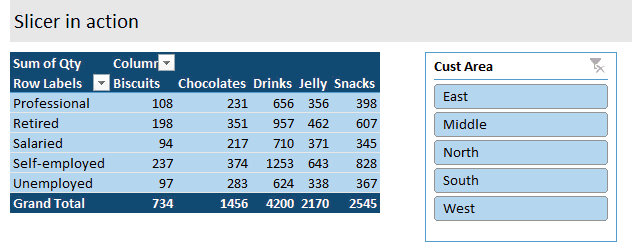
Getting started with Slicers – Video
Here is a quick 5 minute video tutorial on Slicers. If are just getting started with this AWESOME feature, you must watch the video, NOW. See it below or head to my YouTube channel.
Download Slicer Examples Workbook
This post is very long and has many examples. Please click here to download slicer examples demo workbook. It contains all the examples shown in this post and a fun surprise too.
How to insert a slicer?
Note: Slicers are available only in Excel 2010 and above.
Adding a slicer in Excel 2010:
In Excel 2010, you can add a slicer only to pivot tables. To insert a slicer, go to either,
- Insert ribbon and click on Insert Slicer
- or Options ribbon (PivotTable Tools) and click on Insert Slicer
Adding a slicer in Excel 2013 / 2016 / 2019 / 365:
In Excel 2013 and above, you can add a slicer to either pivot tables or regular tables.
Adding slicers to regular tables:
When you add a slicer to regular Excel tables, they just act like auto-filters and filter your table data. To add a slicer to regular table, use Insert ribbon > Insert Slicer button.
Adding slicers to Pivot tables:
To add a slicer, you can do either of these things:
- Right click on pivot table field you want and choose “add as slicer”

- Use either analyze or insert ribbon to add the slicer.

Single vs. Multi-selection in Slicers
You can select a single item or multiple items in slicers. To multi-select,
- If the items you want are together, just drag from first item to last.
- If the items you want are not together, hold CTRL key and click on one at a time.
- You can also click on the “checkbox” icon in slicer header to multi-select items in slicers.
Creating interactive charts with slicers
Since slicers talk to Pivot tables, you can use them to create cool interactive charts in Excel. The basic process is like this:
- Set up a pivot table that gives you the data for your chart.
- Add slicer for interaction on any field (say slicer on customer’s region)
- Create a pivot chart (or even regular chart) from the pivot table data.
- Move slicer next to the chart and format everything to your taste.
- And your interactive chart is ready!
Demo of interactive chart using slicer:
Here is a quick demo.
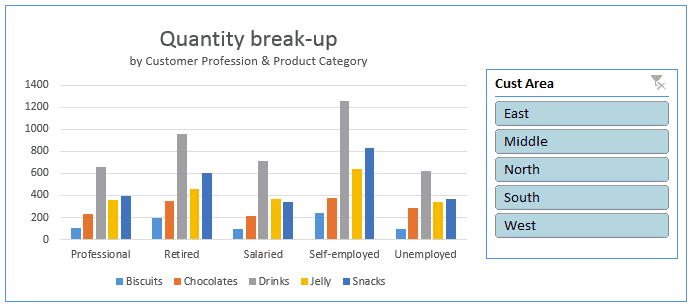
Linking multiple slicers to same Pivot report
You can add any number of slicers to a pivot report. When you add multiple slicers, each of them plays a role in telling the pivot table what sub-set of data to use for calculating the numbers.
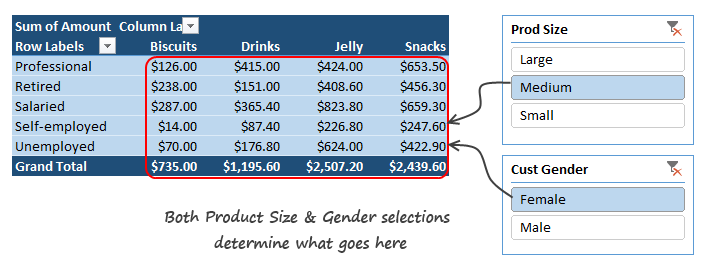
Linking one slicer to multiple pivot tables
You can also link a single slicer to any number of pivot reports. This allows us to build very powerful, cross-filtered & interactive reports using Excel.
To connect multiple pivot tables to single slicer, follow these steps.
- Optional: Give names to each of the pivot tables. To name the pivot tables, click anywhere in the pivot, go to Analyze ribbon and use the pivot table name field on top-left to give it a name.
- If you don’t name your pivot tables, Excel will give them default names like PivotTable73. This can be confusing once you have more than a few pivot tables.
- Right click on the slicer and go to Report Connections (in Excel 2010, this is called as PivotTable connections).

- Check all the pivot tables you want. Click ok.

Now both pivot tables will respond to the slicer. See this demo:
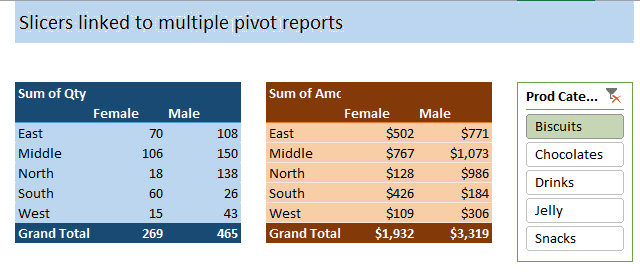
Linking slicers to more than one chart
You can use the same approach to link one slicer to more than one chart (pivot chart or regular one).
See this demo:
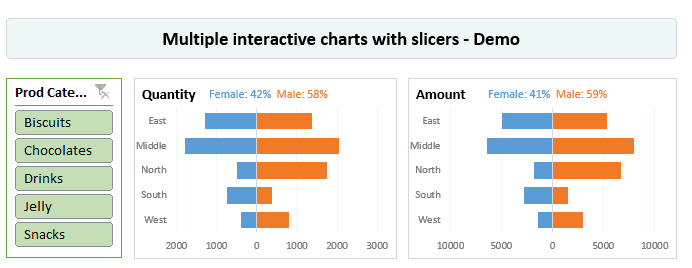
You can examine this chart in detail in the Slicer Examples workbook.
Capturing slicer selection using formulas
While slicers are amazing & fun, often you may want to use them outside pivot table framework. For example, you may want to use slicers to add interactivity to your charts or use them in your dashboard.
When you want to do something like that, you essentially want the slicers to talk to your formulas. To do this, we can use 2 approaches.
- Dummy (or harvester) pivot table route
- CUBE formulas route
Dummy pivot table route
This is the easiest way to capture slicer selection into a cell. Using a dummy pivot table, we can find out which items are selected in slicers and use them for some other purpose, like below:
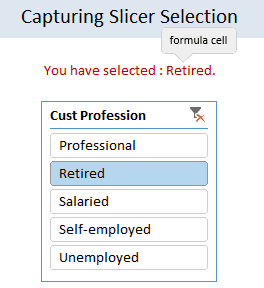
The process is like this:
- Let’s say you want to know which profession is picked up in the slicer (so that you can use it in some formulas or charts).
- Create another pivot table.
- Add the profession field to row labels area.
- Link the slicer to this new pivot table as well (using report connections feature of slicer)
- Now when you click on the slicer, both original pivot and this new dummy pivot change.
- Access row labels like regular cells in your formulas to find out which slicer item is selected.
See this illustration to understand how to set up the formulas:
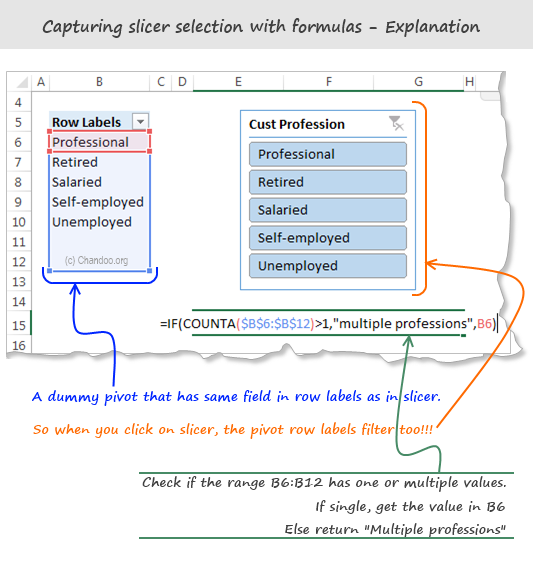
CUBE Formula approach:
This is relevant only if your slicers are hooked up to a data model thru something like Power Pivot, SAS Cubes or ThisWorkbookModel in Excel 2013 or above.
To find out slicer selection, we need to use CUBERANKEDMEMBER() Excel formula like this:
=CUBERANKEDMEMBER(“ThisWorkbookDataModel”, Name_of_the_slicer , item_number)
Let’s say you have a slicer on Area field, and its named Slicer_Area (you can check this name from Slicer properties)
To get the first item selected in the slicer, you can use CUBERANKEDMEMBER formule like this:
=CUBERANKEDMEMBER(“ThisWorkbookDataModel”, Slicer_Area, 1)
This will return the first item selected on slicer. If there is no selection (ie you have cleared the filter on slicer), the Excel will return “All”.
Bonus tip: You can use =CUBESETCOUNT(Slicer_Area) to count the number of items selected in slicer.
Bonus tip#2: By combining CUBESETCOUNT and CUBERANKEDMEMBER formulas, you can extract all the items selected in the slicer easily.
Please download Cube Formula Slicer Selection example workbook to learn more about this approach.
Note: this file works only in Excel 2013 or above.
Formatting slicers
Slicers are fully customizable. You can change their look, settings and colors easily using the slicer tools options ribbon.
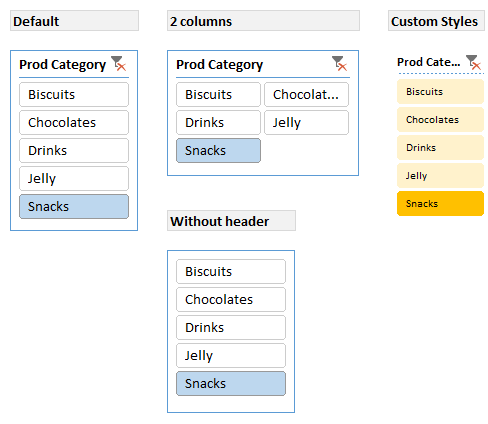
Here is a quick FAQ on slicer formatting:
Q. I have too many items in slicer. How to deal with this problem?
Simple. See if you can set up your slicer in multiple columns. You can also adjust the height and width of slicer buttons to suit your requirements. If your slicer is still too big, you can adjust the font size of slicer by creating a new style.
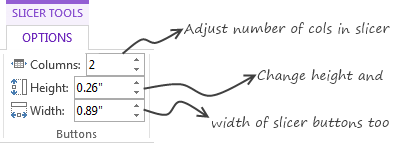
Q. I don’t like the blue color of slicer. What do I do?
You can switch to another color scheme. Just go to Slicer Tools Options ribbon and pick a style you want.
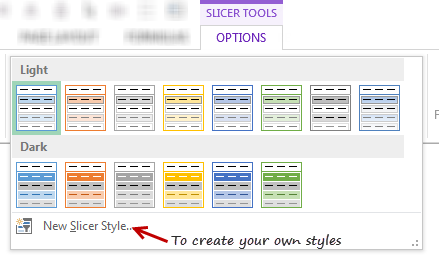
Pro tip: You can create your own style to customize all aspects of a slicer.
Q. I don’t like the title on slicer. Can I get it rid of it?
Yes you can. Right click on the slicer and go to “Slicer Settings”. Uncheck display header option to remove the header & clear filter button.
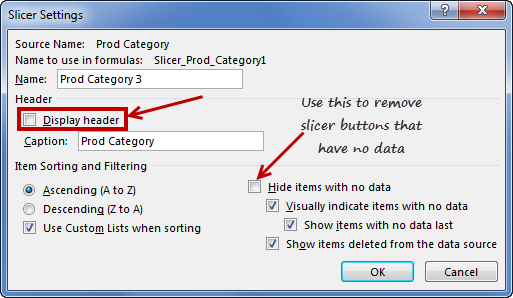
Q. My slicer keeps showing old products (or categories etc.) that are no longer part of data after refresh. What do I do?
Simple. Right click on the slicer and choose “Slicer settings”. Check Hide items with no data option.
Q. I want to make my slicers look good. But I don’t know where to start…
Here is an inspiration for you.
Slicers vs. Report Filters
In a way slicers are like report filters, but way better. (Related: Introduction to Pivot Table Report Filters)
There are few key differences between both.
- Report filters are tied to single pivot tables. Slicers can be linked to any number of pivots.
- Report filters are clumsy to work with. Slicers are very easy to use.
- Report filters may not work very well in a touch screen environment. Slicers are great for touch screen UIs.
- Report filters take up one cell per filter. Slicers take up more space on the worksheet UI.
- Report filters can be automated with simple VBA. Slicers require a bit more code to automate.
- You can access report filter values using simple cell references. Slicer values can be extracted using either dummy pivot tables or CUBE formulas, both of which require extra effort.
Slicers vs. Timelines:
If you have a date field in your data, you can also insert a “timeline”. this is a special type of slicer, that works only with date values.
Here is a quick demo of Timeline slicer.

You can also customize the look & feel of Excel Timelines.
The download workbook has an example of timelines.
Slicers & Compatibility
Slicers are compatible with Excel 2010 & above versions of Excel. You can also use Slicers with Excel Online.
If you create a workbook in Excel 2010 (or above) with slicers and email it to a friend using Excel 2007, they will see an empty box where slicer should be.
Slicers work on desktop & web versions of Excel in the same way.
Download Slicer Examples Workbook
Please click here to download slicer examples demo workbook. It contains all the examples shown in this post and a fun surprise too.
Also download the Cube formulas approach for slicer selection extraction workbook to learn that technique.
Additional Resources to learn about Slicers
If you like slicers and want to learn creative ways to use them in your work, check out below examples:
- Create a fully dynamic dashboard using Pivot Tables & slicers
- Use slicer as scenario selection mechanism
- Slicers + charts for awesome user experience – case study & one more
- Related: Introduction to Excel Relationships & Data Model
- Related: Introduction to Excel Pivot Tables
- Related: Introduction to Excel Report Filters
- Related: Advanced Pivot Table Tips & Tricks
Do you use Slicers? What are your favorite tips about slicers?
As mentioned earlier, slicers are one of my favorite features of Excel. I use them liberally in my dashboards, charts & workbooks.
What about you? Do you use slicers? When do you use them? What are your favorite tips when it comes to using slicers? Please share in the comments area.




















34 Responses to “Find Quarterly Totals from Monthly Data [SUMPRODUCT Formula]”
Chandoo,
Very nice post. In most cases I would use a formula such as yours so that copying is automatic. But for instructional purposes, consider this alternative for the Q1:
=SUMPRODUCT((MONTH(B$4:B$15)={1,2,3})*C$4:C$15)
Besides being shorter, this formula is crystal clear in function. Then for the other quarters you would just change the array constants to the months of that quarter. For example, Q2:
=SUMPRODUCT((MONTH(B$4:B$15)={4,5,6})*C$4:C$15)
Now I know there are a lot of accountant types out there that think using constants in a formula is some sort of heresy. I think that idea is silly. If the formula is clear and maintainable, constants are ok by me. But if this idea shakes anyones soul, these constants could easily be encapsulated in named formulas and then the formula above could look like this:
=SUMPRODUCT((MONTH(B$4:B$15)=Quarter1)*C$4:C$15)
The SUMPRODUCT function is truly magical, as you put it. This article goes into some advanced uses:
http://www.excelhero.com/blog/2010/01/the-venerable-sumproduct.html
Regards,
Daniel Ferry
excelhero.com
I have a column of dates(xx/xx/xx) on a sheet that represents when a task is completed. How do I code a formula on a separate sheet(Summary Page) of the total number of completions within a quarter?
ie;
Task Date Completed
task1 02/05/14
task2 04/01/14
task3 08/01/14
I need a formula that scans that column and then adds the number of tasks completed within each quarter of the year.
Chandoo,
as usual, great tip.
Ever since i read this post, I am struggling with a table that has the same layout as the example, and I wanted to add the totals per year and per Q, years as rows, Qs as columns. The first thing I've noticed is that I had to add the double minus to the roundup portion in order to make it work, even my dates ARE dates...but what i cannot figure out is how to summarize by year. I've tried adding a Year(a1:a20)=2010 to the sumproduct, but it returns 0, and I have the Pivot table below to prove that wrong (aaah, how easy was to have that with the pivot table....!!)
btw, I was playing around with PTs, adding calculated fields and items to solve variations between Actuals and Budgets and Prior Years. Once you get the formulae right, it's sooooo easy to do, and the results are awesome !!!
all the best,
Martín
Amended Chandoo's formula to add a year and it worked fine.
SUMPRODUCT((YEAR($B$4:$B$15)=2010)*(ROUNDUP(MONTH($B$4:$B$15)/3,0)=ROWS($E$4:F4))*$C$4:$C$15)
Chandoo
I generally do quarters in the same way galthough I would have changed the number format of cells E4:E7 to Q0, so that I could reduce to formula length by referring directly to these cells. SUMPRODUCT((ROUNDUP(MONTH($B$4:$B$15)/3,0)=E4)*$C$4:$C$15).
I like Daniel's suggestion of a named range. Great site.
Thanks Chandoo,
I use a tbl to create relationshipp for each period to its quartile
Jan Q1
Feb Q1
Mar Q1
Create a lookup in a helper column to lookup the correct quartile.
Use Sumif on the column with the quartile
Best regards,
Winston
@Daniel: Excellent insights as always. I am finding SUMPRODUCT formula really really powerful.
I didnt know that we can write conditions like ={1,2,3}. I remember trying that but it didnt work. thanks for telling me how to do it. I like your idea of named ranges. It will keep things simple and also let the reports to easily transformed if one needs to change Q1 from JAN-MAR to APR-JUN.
@Martin: See Alan's comments. Also, I liked your question, so I am doing a follow up post on it today. Refer to it to find out how you can get quarterly totals from multi-year monthly data.
@Alan: Very good tips. Thank you. Infact, in the download file you would find the formula to be slightly different. I used ROWS() so that I need not change the values for each quarter. I guess either technique works fine.
@Winston: Thanks for sharing your technique. Using helper columns is a fine option too. It keeps the formulas clean and simple. I was just curious and investigated to find if there is a formula that would avoid helper columns.
Chandoo, I learn so much from your posts. Thank you for this!
I was wondering, how would this get applied to a dashboard with a dynamic date slider?
Right now I show sales for the week, month, and year based on the date I choose. I've yet to discover how to calculate quarterly numbers based on my date selection.
My date is determined by: =DATE(2018,12,31)+7*(A2-1) with A2 updating based on the slider.
Sales This Month is calculated as: =SUMPRODUCT((MONTH(Data[Order Date])=MONTH(D2))*(Data[Sales Amount])) with D2 containing the date formula above.
ANy suggestions?
Thanks for your question Jason.
It seems you have data at date (or even lower level). In such cases, you need either two conditions or probably SUMIFS to solve this. For example with SUMIFS,
=SUMIFS(data[sales amount], data[order date],">="&quarter_start, data[order date],"<"&quarter_end) where quarter_start = date(year(a2), choose(month(a2), 1,1,1,4,4,4,7,7,7,10,10,10), 1) and quarter_end = date(year(a2), choose(month(a2), 4,4,4,7,7,7,10,10,10,13,13,13), 1) can work.
How about if we have the data in weeks and we want to roll it up in Q1, Q2, Q3, Q4
will this work for Q1:
=SUMPRODUCT((MONTH(B$4:B$15)={1,2,3,4,5,6,7,8,9,10,11,12,13})*C$4:C$56)
nice article to use the new things on the excel to calculate the needed ports...The use of tables shows the image view than the wordings, since images are easily recorded in the mind of users than the words to be read...
[...] Quarterly data in a formula May 4, 2010 at 9:12 AM | In General | Leave a Comment Tags: month, formulas, flag, quarter, sumproduct Chandoo wrote a post about combining the power of SUMPRODUCT with a small mathematical trick in order to calculate a quarterly sum from a monthly data table. [...]
I have an issue, much different yet has some similarities...
I have two worksheets... 'Summary' worksheet and 'Stop pays' worksheet.
The summary sheet has the $ amount of checks paid each week. (example. A1= 1/1/10, B1= $100,000.00; A2= 1/8/10, B2= $120,000.00, A3= 1/15/10, etc...for 52 weeks)
On the stop pays sheet is a list format of each check that was voided at a later date... (example. column A= original check date, column B= check voided amount, column C= void date. A2= 1/1/10, B2= -$100.00; A3 = 1/1/10, B3= -$150.00; A4= 1/1/10, B4= -50.00; etc...)
On the summary sheet in C1, I need to calculate the total checks actually paid out. I have been trying to use combinations of SUMPRODUCT with VLOOKUPS, but can't get anything to work. The result in C1 should $99,700.00
Any thoughts, all help is appreciated. Thanks, Kyle
@Kyle
Give this a try in Summary!C1 and copy down
=SUM($B$1:B1)+SUMPRODUCT(1*('Stop Pays'!A2:A100<=Summary!A1)*('Stop Pays'!$B$2:$B$100))
@Kyle... you can use sumif formula...
Assuming your summary sheet is in range A1:B10, stop pays sheet is in range A1:B20.
in summary c1 write = b1 - sumif('stop pays'!$a$1:$a$20,a1,'stop pays'!$b$1:$b$20)
Read more about sumif formula here: http://chandoo.org/wp/2008/11/12/using-countif-sumif-excel-help/
@Hui. Thanks, but for some reason this only worked for the first row (C1), when I copied down the results werent accurate.
@Chandoo. This seems to work perfectly. Thank you.
Thanks again.
@ Kyle
Chandoo's formula is giving the amount each month (Cheques - Stop Pays)
Mine is giving a running total from 1/1/10 to the date in Summary!Column A
I have monthly data in one sheet and want to calculate quarterly and annual data is two other sheets. all monthly data is arranged across columns. so A1 is jan 2000, b1 is feb 2000, c1 is march 2000 and so on.
Please help
@Priyank: Assuming your months are (in date format) in A1:X1 and corresponding values are in A2:X2, you can calculate quarterly totals like this:
=SUMPRODUCT((ROUNDUP(MONTH(A1:X1)/3,0)=1)*(A2:X2)) for Q1. Modify it to get Q2... etc.
you can use similar logic with YEAR() to get yearly totals.
This formula is not working properly in one of my sheets with horizontal cash flows using columns instead of rows. For example, Q1 only sums M1 and Q2 is summing up M2:M4. It doesn align propoerly. The formula works if I create a simple test using same format in excel but not in the model. Can I send the excel to someone?
Thanks,
Marc
Item 01-Mar 02-Mar 03-Mar 04-Mar Tot.
Soap 24 12 15 13 (E5-F5)+(G5-F5)+(G5-H5)
Ketchup 12 10 8 14
Tea 10 8 5 8
Soup 12 7 9 11
Coffee 22 26 14 13
Hi!!,
I need your help in fixing above problem.
I do get day day wise closing stock of my company.To get day sales have to
substract today's no from prev.day's no. But sometimes today's no is big due to receipt of stock.That time I need to substract prev.day's no from today'no. Pls see formula in tot column.Like this I have to do for 31 days and 250 items.I want one formula in one cell give final result(tot)by satisfying above conditions else I have to punch a formula in above column which is boring ang time consuming.Thanks in advance.
Hi Chandoo et al,
My question builds on the post regarding quarterly totals from monthly data. I'm having trouble getting the formula to work when the time period I want quarterly totals for exceeds 12 months. In my case, I have 240 months and need these to be collapsed into 60 quarters. Any suggestions? Or should I simply cut and paste the formula for each 12 month period?
thanks
Hi Chandoo,
I have a similar problem, but with a twist. I often compare actual and budget data where the actuals are in one range with Jan-Dec data and the budget is another range with Jan-Dec data.
The problem I have is that at the beginning of the year I know the budget for all 12 months, so my range is populated for Jan-Dec. The actual data is populated as we complete those months.
Here's the rub: when caluclating totals for Oct, say, the formula to retrieve Q4 data needs to be smart enough to NOT include the November and December budget amounts, which are already populated in the table.
how can I do the same using SQL query?plz help
[…] Find Quarterly Totals from Monthly Data [SUMPRODUCT Formula] | Chandoo.org - Learn Microsoft Excel O… […]
How do we use this for getting totals for the latest qtr? anybody?
My challenge is I don't want to use a helper column. Want to derive the latest qtr and then average the numbers for that qtr . Ex this gives an error :
AVERAGEIF((ROUNDUP(MONTH($A$2:$A$7)/3,0),(ROUNDUP(MONTH(MAX($A$2:$A$7))/3,0)),B2:B7))
Hi
I am arranging a spread sheet for work but am struggling with a date function. we have customers in our service for up to 2 yrs, however we have to calcuate the number of days they have been in service each quarter. For example Q1 will run from 15/01/15 to 06/04/15 but my customer could have joined on 03/09/14 ... i don't want to calulate all the days just the days in the quarter... which should be upto 91 days max. Can any one help at all?
Dear all
I can see your formula and I think it works perfectly for what I want to achieve, ie pull quarterly figures from a range showing monthly data. There's only one problem. I cannot follow how the sumproduct formula is working in this case. Could anyone please help with an explanation on what is going on in that formula so I can hopefully be able to apply it.
Thanks
Hi,
I need to come up with a way to show the current quarters info, this would be run off the month end date.
For example: If the month end date is 28.2 then I need to bring back Jan data and Feb data or if the end date was 31.3 I would need to total Jan, Feb and Mar data.
I am thinking of creating unique references such as the quarter plus which month it is in the quarter ie if it was feb, the unique reference would be Q12 (Q1 for the quarter and 2 for the month as it is the 2nd month in the quarter). Would I need to use an index or offset formulae.........
Any help would be appreciated.
Greetings,
Can we make this a little more involved just month and sales results.
What if I have the following columns:
Vendor Name
Market
Line of Business
Month
Sales
Now I want to calculate the average quarterly sales by vendor, Market, and Line of Business
Hello Hesham... thanks for your question. You should use Pivot Tables for such things. See here for a getting started guide - https://chandoo.org/wp/excel-pivot-tables-tutorial/
Im a little confused, I have the following table of sales
Sales Sheet
ColA=dates(dd/mm/yyyy)
ColE=amount(total amount of sales in $)
eg
A E
11/02/2020 $20.00
01/01/2020 $15.00
03/12/2020 $16.00
05/07/2020 $23.00
etc etc
Report Sheet
I want to report the running total of sales for each quarter and update the figures here as more get added
Cell B2= Quarter1 total
Cell B5= Quarter2 total
Cell B8= Quarter3 total
Cell B11= Quarter4 total
How do I read the Sales Sheet column A selecting all dates for each quarter and sum total them in The Report sheet. I have tried mucking about with your formula but I just keep getting errors, any help much appreciated
I have problem Statement, my data are monthly i need to do comparison at QTD level say i am second quarter May (so my data should only pick April and May total) and( when in June it should pick Apr+ May +June) - can i your help on this
Jan Feb Mar Apr May Jun Jul Aug Sep Oct Nov Dec
1 2 3 4 5 6 7 8 9 10 11 12